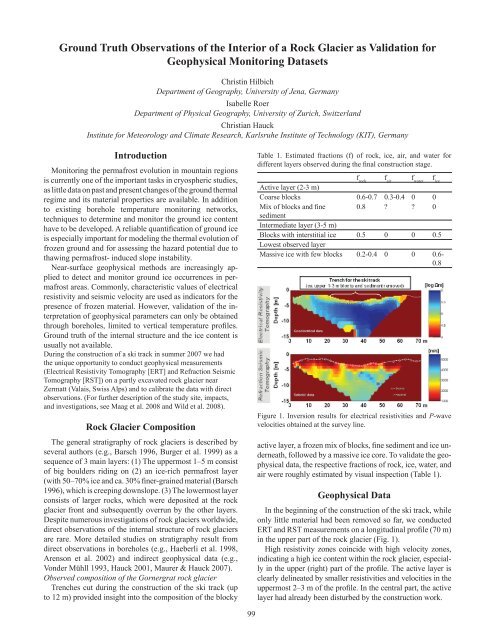Ninth International Conference on Permafrost ... - IARC Research
Ninth International Conference on Permafrost ... - IARC Research
Ninth International Conference on Permafrost ... - IARC Research
Create successful ePaper yourself
Turn your PDF publications into a flip-book with our unique Google optimized e-Paper software.
Ground Truth Observati<strong>on</strong>s of the Interior of a Rock Glacier as Validati<strong>on</strong> forGeophysical M<strong>on</strong>itoring DatasetsChristin HilbichDepartment of Geography, University of Jena, GermanyIsabelle RoerDepartment of Physical Geography, University of Zurich, SwitzerlandChristian HauckInstitute for Meteorology and Climate <strong>Research</strong>, Karlsruhe Institute of Technology (KIT), GermanyIntroducti<strong>on</strong>M<strong>on</strong>itoring the permafrost evoluti<strong>on</strong> in mountain regi<strong>on</strong>sis currently <strong>on</strong>e of the important tasks in cryospheric studies,as little data <strong>on</strong> past and present changes of the ground thermalregime and its material properties are available. In additi<strong>on</strong>to existing borehole temperature m<strong>on</strong>itoring networks,techniques to determine and m<strong>on</strong>itor the ground ice c<strong>on</strong>tenthave to be developed. A reliable quantificati<strong>on</strong> of ground iceis especially important for modeling the thermal evoluti<strong>on</strong> offrozen ground and for assessing the hazard potential due tothawing permafrost- induced slope instability.Near-surface geophysical methods are increasingly appliedto detect and m<strong>on</strong>itor ground ice occurrences in permafrostareas. Comm<strong>on</strong>ly, characteristic values of electricalresistivity and seismic velocity are used as indicators for thepresence of frozen material. However, validati<strong>on</strong> of the interpretati<strong>on</strong>of geophysical parameters can <strong>on</strong>ly be obtainedthrough boreholes, limited to vertical temperature profiles.Ground truth of the internal structure and the ice c<strong>on</strong>tent isusually not available.During the c<strong>on</strong>structi<strong>on</strong> of a ski track in summer 2007 we hadthe unique opportunity to c<strong>on</strong>duct geophysical measurements(Electrical Resistivity Tomography [ERT] and Refracti<strong>on</strong> SeismicTomography [RST]) <strong>on</strong> a partly excavated rock glacier nearZermatt (Valais, Swiss Alps) and to calibrate the data with directobservati<strong>on</strong>s. (For further descripti<strong>on</strong> of the study site, impacts,and investigati<strong>on</strong>s, see Maag et al. 2008 and Wild et al. 2008).Rock Glacier Compositi<strong>on</strong>The general stratigraphy of rock glaciers is described byseveral authors (e.g., Barsch 1996, Burger et al. 1999) as asequence of 3 main layers: (1) The uppermost 1–5 m c<strong>on</strong>sistof big boulders riding <strong>on</strong> (2) an ice-rich permafrost layer(with 50–70% ice and ca. 30% finer-grained material (Barsch1996), which is creeping downslope. (3) The lowermost layerc<strong>on</strong>sists of larger rocks, which were deposited at the rockglacier fr<strong>on</strong>t and subsequently overrun by the other layers.Despite numerous investigati<strong>on</strong>s of rock glaciers worldwide,direct observati<strong>on</strong>s of the internal structure of rock glaciersare rare. More detailed studies <strong>on</strong> stratigraphy result fromdirect observati<strong>on</strong>s in boreholes (e.g., Haeberli et al. 1998,Arens<strong>on</strong> et al. 2002) and indirect geophysical data (e.g.,V<strong>on</strong>der Mühll 1993, Hauck 2001, Maurer & Hauck 2007).Observed compositi<strong>on</strong> of the Gornergrat rock glacierTrenches cut during the c<strong>on</strong>structi<strong>on</strong> of the ski track (upto 12 m) provided insight into the compositi<strong>on</strong> of the blockyTable 1. Estimated fracti<strong>on</strong>s (f) of rock, ice, air, and water fordifferent layers observed during the final c<strong>on</strong>structi<strong>on</strong> stage.f rockf airf waterf iceActive layer (2-3 m)Coarse blocks 0.6-0.7 0.3-0.4 0 0Mix of blocks and fine 0.8 ? ? 0sedimentIntermediate layer (3-5 m)Blocks with interstitial ice 0.5 0 0 0.5Lowest observed layerMassive ice with few blocks 0.2-0.4 0 0 0.6-0.8Figure 1. Inversi<strong>on</strong> results for electrical resistivities and P-wavevelocities obtained at the survey line.active layer, a frozen mix of blocks, fine sediment and ice underneath,followed by a massive ice core. To validate the geophysicaldata, the respective fracti<strong>on</strong>s of rock, ice, water, andair were roughly estimated by visual inspecti<strong>on</strong> (Table 1).Geophysical DataIn the beginning of the c<strong>on</strong>structi<strong>on</strong> of the ski track, while<strong>on</strong>ly little material had been removed so far, we c<strong>on</strong>ductedERT and RST measurements <strong>on</strong> a l<strong>on</strong>gitudinal profile (70 m)in the upper part of the rock glacier (Fig. 1).High resistivity z<strong>on</strong>es coincide with high velocity z<strong>on</strong>es,indicating a high ice c<strong>on</strong>tent within the rock glacier, especiallyin the upper (right) part of the profile. The active layer isclearly delineated by smaller resistivities and velocities in theuppermost 2–3 m of the profile. In the central part, the activelayer had already been disturbed by the c<strong>on</strong>structi<strong>on</strong> work.99
















